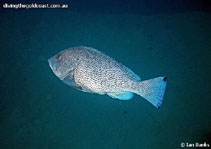| Family: |
Epinephelidae (Groupers) |
| Max. size: |
122 cm TL (male/unsexed); max.weight: 17 kg |
| Environment: |
reef-associated; marine; depth range 2 - 150 m |
| Distribution: |
Western Pacific: southern Japan to southern Queensland and east to Fiji and the islands of Micronesia. Recently recorded from Tonga (Ref. 53797). Record from Western Australia in the Indian Ocean is dubious. Replaced by Epinephelus flavocaeruleus in the Indian Ocean (Ref. 37816). |
| Diagnosis: |
Dorsal spines (total): 11-11; Dorsal soft rays (total): 16-17; Anal spines: 3-3; Anal soft rays: 8-8. Juveniles are mostly yellow becoming gray with dark spots anteriorly. The gray area increases with increasing size until only the fins remain yellow on individuals of 15 to 20 cm (Ref. 37816).
Description: Characterized by pale bluish grey color with black spotting overall; body scales ctenoid except cycloid anterodorsally and on thorax and abdomen; body with auxiliary scales; relatively deep bodied, greatest depth 2.4-2.7 in SL; truncate to very slightly emarginate caudal fin; short pelvic fins, 1.7-2.0 in head length (Ref. 90102). |
| Biology: |
Usually found around isolated coral heads in lagoons or bays, but also caught on outer reef area. According to Myers (1989, Ref. 4538) it usually swims out in the open, several meters above the bottom. It is readily caught by anglers at night. Feeds mainly on sand-dwelling fishes and crustaceans such as snake eels and box crabs. In Hong Kong live fish markets (Ref. 27253). |
| IUCN Red List Status: |
Least Concern (LC); Date assessed: 22 November 2016 Ref. (130435)
|
| Threat to humans: |
reports of ciguatera poisoning |
Source and more info: www.fishbase.org. For personal, classroom, and other internal use only. Not for publication.
